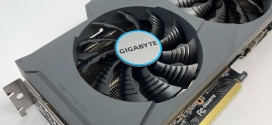GIGABYTE has revealed a total of 10 Z77 boards for the next generation of Intel chipsets and CPU’s. Among them is the elite gamer G1.Sniper 3. Keep reading to check it out!
Gigabyte Z77 Motherboards: A Preview
The highly anticipated successor to the Sandy Bridge is just around the corner and the motherboard manufacturers are all eager to show off their latest creation. The upcoming socket 1155 motherboard will support second and third generation Intel Core CPUs.
We previewed the MSI Z77-GD65 last week, and today we’re looking at GIGABYTE’s line up. GIGABYTE has a total of ten motherboards available. Nine of the boards are based on the Z77 chipset while one of them uses the H77 chipset.
- G1.Sniper 3
- GA-Z77X-UD5H WiFi
- GA-Z77X-UD5H
- GA-Z77X-UD3H
- GA-Z77X-D3H
- G1.Sniper M3
- GA-Z77-D3H
- GA-Z77MX-D3H
- GA-Z77M-D3H
- GA-H77-D3H
Besides the chipset difference, the main difference between the model numbers is that the boards designated “Z77X” support CrossFireX and SLI in dual x8 configuration. While all motherboards will support CrossFireX, only the “X” models will support CrossFireX and SLI in dual x8 configuration. The “U” are designation is for boards that feature GIGABYTE’s Ultra Durable 4 while “D” is for boards with Ultra Durable 4 Classic. As far as we can tell the main difference between the Classic and non-classic Ultra Durable 4 is the non-classic features the 2oz of copper for PCB that helps with heat dissipation. Finally, “M” designated boards have an mATX form factor while non-M have an ATX form factor.

All boards will feature GIGABYTE’s 3D Power, 3D BIOS, EZ Smart Response, UEFI BIOS, Japanese Solid capacitors, and On/Off USB charge.
The 3D Power is GIGABYTE’s branding for all digital controllers that manage power going into the motherboard, memory, CPU, and VTT. The digital controller will feature Precise Auto Voltage Compensation, allowing the CPU and memory voltage to match their target voltage quicker, which will improve overclocking performance and power saving.
The entire line of the motherboard will feature the updated 3D BIOS based on the GIGABYTE UEFI DualBIOS technology where it offers two modes of interaction.
A new “Virtu MVP” technology will add new features called Hyperperformance where the software will improve gaming performance by reducing the redundant rendering task in the flow between the CPU, GPU and display. According to Lucid, this will boost the gaming frame rate by 30-70% and increases Vsync frame rates up to 120 FPS and beyond.
The family portrait
The top of the line from GIGABYTE is the G1.Sniper 3. The board features a total of 10 SATA ports with 6 of them supporting SATA 6Gbps. In addition, it comes with ten USB 3.0, four USB 2.0, two FireWire ports. For networking and connectivity, the board comes with two Gigabit LAN ports, Wi-Fi and Bluetooth 4.0. A total of four PCI-E x16 slots are available with the help of the additional PLX chip to give the ability to support 4-way x8 multi-GPU setup. An improved audio is also included thanks to the the Creative Sound Core 3D as opposed to the standard Realtek chip. The mSATA is also a standard here as well for those who need faster performance. All together, this is the best board that will be available.
There is also a mATX G1.Sniper M3 available for those who are looking to build a portable gaming PC. The reduction of board size also means fewer ports and slots. Here we only get one PCI-E x16 and PCIE x8 for dual-GPU configuration. The SATA 6Gbps ports have been reduced to two and the USB 3.0 have been cut to 4. One ethernet port is included courtesy of Intel. The mSATA and WiFi+Bluetooth 4.0 have also been removed.
A step down from the G1.Sniper 3 are the GA-Z77X-UD5H WiFi and GA-Z77X-UD5H. We presume the only difference between the two is the WiFi and Bluetooth 4.0 support. The board will have the same number of USB, FireWire, and Ethernet port as the G1.Sniper 3. While the G1.Sniper 3 comes with 4 PCI-E X16 slots, the UD5H boards only have two for x8 dual-GPU configuration. The audio chip is based on Creative X-Fi MBII SW and mSATA is also supported. All in all, it is a nice board for those who do not need the extra PCI-E x16 slots.
GA-Z77X-UD3H (left) and the GA-Z77X-D3H (right)
Moving toward more mainstream is the GA-Z77X-UD3H that swapped out the Creative audio with the standard Realtek VIA audio. Additionally, the board lacks any FireWire port, and only comes with one Gigabit Ethernet port. There is also a reduction of two USB 3.0 ports and two SATA 6Gbps ports. However, the mSATA port is still here.
GA-Z77M-D3H (left) and GA-Z77MX-D3H
The GA-Z77MX-D3H and GA-Z77M-D3H are both mATX form factor with one PCIE 3.0 x16. Both boards have two SATA 6Gbps and four SATA 3Gbps, four USB 3.0 and 10 USB 2.0, and a single Gigabit LAN port. The main difference between the two is the Z77MX-D3H comes with a second PCI-E 3.0 x8 for dual GPU configuration while the Z77M-D3H has a PCI-E 2.0 x4.
Lastly, the GA-H77-D3H is the only board in the lineup to use the H77 chipset instead of the Z77. The board is very similar to the Z77M-D3H except that it is ATX form factor and has two more USB 3.0 ports.
If you need a more detailed difference between the boards, check out GIGABYTE ‘s site fore more information.
 Bjorn3D.com Bjorn3d.com – Satisfying Your Daily Tech Cravings Since 1996
Bjorn3D.com Bjorn3d.com – Satisfying Your Daily Tech Cravings Since 1996




















i have GA-z77x-ud3h and i want to operate 6 gpu for mining and it is unstable
please i want the configuration of bios